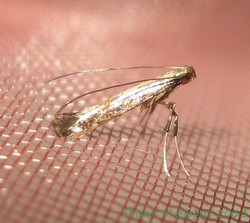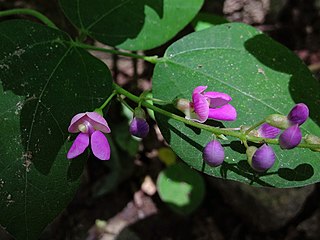
A bean is the seed of several plants in the family Fabaceae, which are used as vegetables for human or animal food. They can be cooked in many different ways, including boiling, frying, and baking, and are used in many traditional dishes throughout the world.

Phaseolus is a genus of herbaceous to woody annual and perennial vines in the family Fabaceae containing about 70 plant species, all native to the Americas, primarily Mesoamerica.

Phaseolus acutifolius, also known as the tepary bean, is a legume native to the southwestern United States and Mexico and has been grown there by the native peoples since pre-Columbian times. It is more drought-resistant than the common bean and is grown in desert and semi-desert conditions from Arizona through Mexico to Costa Rica. The water requirements are low. The crop will grow in areas where annual rainfall is less than 400 mm (16 in).

Phaseolus coccineus, known as runner bean, scarlet runner bean, or multiflora bean, is a plant in the legume family, Fabaceae. Another common name is butter bean, which, however, can also refer to the lima bean, a different species.

A lima bean, also commonly known as the butter bean, sieva bean, double bean or Madagascar bean is a legume grown for its edible seeds or beans.

Phaseolus vulgaris, the common bean, is a herbaceous annual plant grown worldwide for its edible dry seeds or green, unripe pods. Its leaf is also occasionally used as a vegetable and the straw as fodder. Its botanical classification, along with other Phaseolus species, is as a member of the legume family Fabaceae. Like most members of this family, common beans acquire the nitrogen they require through an association with rhizobia, which are nitrogen-fixing bacteria.
Red bean is a common name for several plants and may refer to:

Green beans are young, unripe fruits of various cultivars of the common bean, although immature or young pods of the runner bean, yardlong bean, and hyacinth bean are used in a similar way. Green beans are known by many common names, including French beans, string beans, and snap beans or simply "snaps." In the Philippines, they are also known as "Baguio beans" or "habichuelas" to distinguish them from yardlong beans.
Pseudoviridae is a family of viruses, which includes three genera.
Colin Louis Avern Leakey was a leading plant scientist in the United Kingdom, a Fellow of King's College, Cambridge and of the Institute of Biology, and a world authority on beans.

Gigantes plaki or Greek giant baked beans, is a Greek dish of large white beans baked in a tomato sauce. Gigantes plaki may be served as a main dish or as a meze. The beans are traditionally fasolia gigantes 'giant beans', a variety of the Phaseolus coccineus.
In enzymology, a 3-ethylmalate synthase (EC 2.3.3.7) is an enzyme that catalyzes the chemical reaction

Guitarrero Cave is located in the Callejón de Huaylas valley in Yungay Province, in the Ancash region of Peru. The cave stands 50 m (160 ft) above the Santa River and 2,580 m (8,460 ft) meters above sea level.

Porphyrosela aglaozona is a moth of the family Gracillariidae. It is known in Australia in the states of New South Wales, Queensland and Victoria and on Fiji.

Phodoryctis caerulea is a moth of the family Gracillariidae. It is known from India, Malaysia (Sabah), Indonesia (Java), Sri Lanka, Fiji, Guam, the Solomon Islands, Japan and Taiwan, as well as Madagascar, Mauritius, Réunion, Uganda and Tanzania.
Caloptilia soyella is a moth of the family Gracillariidae. It is known from Cape Verde, China, Fiji, India, Indonesia (Java), Japan, Sri Lanka and Vietnam.
Phaseolus angustissimus is a perennial, herbaceous vine of the Fabaceae (legume) family, native to the American Southwest, as well as northern Sonora, Mexico. It is a close relative of the cultivated tepary bean, also native to the same region.

Phaseolus polystachios, also known as the thicket bean or wild kidney bean, is a perennial, herbaceous vine that is native to North America. It is unique among the Phaseolus in that its native range extends across the eastern temperate United States to southeast Canada, while most Phaseolus are tropical or subtropical. It is the namesake for the Polystachios group clade, which is the most species-rich within Phaseolus. In spite of its common name, it is more closely related to the lima bean, and it holds potential as a crop wild relative due to its resistance to white mold.
Phaseolus dumosus, the year bean or year-long bean, is an annual to perennial herbaceous vine in the family Fabaceae (legumes), native to a narrow region in the highlands of Guatemala. It is one of the five Phaseolus domesticates and is similarly used for its beans. It was recently found to be a hybrid between two other cultivated species of Central America, Phaseolus coccineus and P. vulgaris and displays intermediate characteristics. Taxonomically, it was previously categorized as Phaseolus polyanthus and P. coccineus ssp. darwinianus.
Phaseolidae is a family of bivalves belonging to the order Nuculanida.











